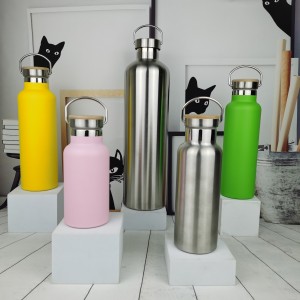Stainless steel thermos cups are widely used in modern life. Their efficient thermal insulation performance and durability make them an indispensable item in people’s daily lives. However, the choice of material is crucial to the quality and safety of the thermos cup. Although 201 stainless steel has certain uses in certain applications, as a production material for stainless steel thermos cups, it has some obvious inadequacies.
Here are a few key reasons:
1. Insufficient corrosion resistance: Stainless steel thermos cups are often in contact with liquids such as water and beverages, and the corrosion resistance of 201 stainless steel is relatively poor. 201 stainless steel contains higher levels of manganese and nitrogen, which makes it susceptible to corrosion in chlorine-containing environments. Chlorine and other chemicals in drinking water may react with 201 stainless steel, causing corrosion on the surface of the cup wall, thus affecting the safety and appearance of the thermos cup.
2. Health and safety issues: The ingredients in 201 stainless steel may cause some health and safety issues. It contains high levels of manganese and chromium, which may cause chronic toxicity through long-term exposure. Although it is unlikely that the liquid in the cup will come into direct contact with the material, there are certain health risks, especially for long-term use.
3. Poor thermal insulation performance: One of the main functions of the stainless steel thermos cup is to maintain the temperature of the liquid. The thermal conductivity of 201 stainless steel is high, which may result in the thermal insulation effect being inferior to other materials, such as 304 stainless steel, and the thermal insulation time is shorter, which affects the practical value of the thermos cup.
4. Quality stability issues: The composition and performance of 201 stainless steel are relatively unstable, which means that there may be certain fluctuations in material quality during the manufacturing process. This will affect the quality stability and reliability of the stainless steel thermos cup, making it difficult to meet the requirements for long-term use.
5. Nickel release problem: The nickel content in 201 stainless steel is low, but there is still a certain risk of nickel release. Some people are allergic or sensitive to nickel, which may cause allergic reactions. To ensure the health and safety of users, it is crucial to avoid materials that may cause allergy issues.
To sum up, although 201 stainless steel has certain advantages in certain scenarios, its corrosion resistance, health and safety, income insulation performance and quality stability make it unsuitable as stainless steel. Production materials for thermos cups. Choosing suitable materials such as high-quality, certified 304 stainless steel can ensure that the thermos cup can be reliably guaranteed in terms of insulation performance, safety and durability.
Post time: Nov-14-2023
